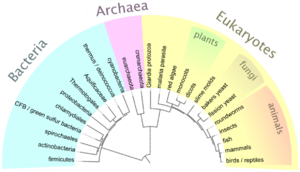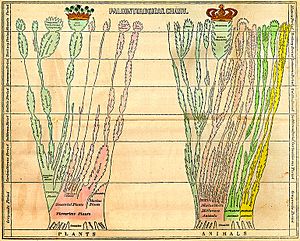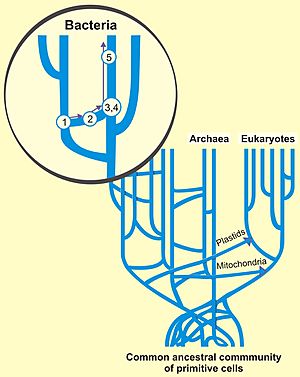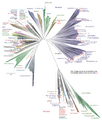Tree of life (biology) facts for kids
The tree of life is a way of thinking about how all living things are connected. It shows that all life on Earth shares a common ancestor, meaning we all came from the same starting point long, long ago.
Charles Darwin was the first to use this idea in modern biology. He used it to explain how different species have changed over time.
This "evolutionary tree" helps us see how different groups of living things are related. Scientists use information from DNA, RNA, and proteins to build these trees. They also look at how animals and plants are built, and how their tiny molecules have changed over time.
Contents
Early Ideas About Life's Tree
Even before Darwin, some people had ideas about how life might be connected.
Lamarck's Branching Tree
Jean-Baptiste de Lamarck (1744–1829) created one of the first branching diagrams of animals in 1809. His tree started with simple creatures like worms and ended with mammals. It was like an upside-down tree!
However, Lamarck didn't believe that all life came from one common ancestor. He thought that life started many times and then slowly became more complex in separate lines.
Hitchcock's Paleontology Chart
The American geologist Edward Hitchcock (1763–1864) published a "tree of life" in 1840. It was based on paleontology, which is the study of fossils. His chart showed different time periods going up the side.
Hitchcock made separate trees for plants and animals. These trees were not connected at the bottom, and each started in many places. He didn't think they showed evolution as we understand it today. He believed a deity (a god) was responsible for the changes.
Early Ideas of Development
In 1844, a book called Vestiges of the Natural History of Creation was published. It had a diagram that looked like a tree. This diagram showed how different animals might develop from simpler forms. For example, fish (F), reptiles (R), and birds (B) were shown as branches leading to mammals (M).
The book suggested that life on Earth might have branched out in a similar way over time.
Darwin's Revolutionary Tree
Charles Darwin (1809–1882) was the first to draw an evolutionary tree of life. He was careful about how much we could truly know about life's history.
In his famous book, On the Origin of Species (1859), Darwin included a simple diagram of a theoretical tree. It showed how different types of living things could branch off from each other over time.
Darwin explained that small differences between living things could grow bigger over many generations. This could lead to completely new species and even new groups of animals or plants. His diagram showed a branching pattern without specific names, unlike some later, more detailed trees.
The Tree of Life Today
The idea of a tree still works well for eukaryotic life forms. Eukaryotes are living things whose cells have a nucleus, like animals, plants, fungi, and protists. Scientists are still figuring out the earliest branches of the eukaryote tree. They are not yet sure if there are four or two main "supergroups." It's a complex puzzle!
However, biologists now know that prokaryotes, which are very simple living things like bacteria and archaea, can share genetic information in a different way. This is called horizontal gene transfer (HGT).
Imagine if you could share your DNA directly with your friend, even if they weren't your child! That's a bit like what horizontal gene transfer is. It means that genes can move between different types of bacteria and archaea, not just from parent to offspring.
Because of horizontal gene transfer, the simple "tree of life" doesn't fully explain how bacteria and archaea evolve. While the tree model was very helpful for understanding basic evolution, scientists now know that life's story is even more complex.
Images for kids
-
The tree of life image that appeared in Darwin's The Origin of Species, 1859. It was the book's only illustration
See also
 In Spanish: Árbol de la vida (biología) para niños
In Spanish: Árbol de la vida (biología) para niños












